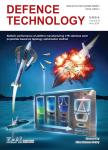Thermal and ignition properties of hexanitrostilbene(HNS) microspheres prepared by droplet microfluidics
作者机构:State Key Laboratory of Explosion and TechnologyBeijing Institute of TechnologyBeijing100081China Science and Technology on Applied Physical Chemistry LaboratoryShaanxi Applied Physics-Chemistry Research InstituteXi'an710061ShaanxiChina
出 版 物:《Defence Technology(防务技术)》 (Defence Technology)
年 卷 期:2023年第25卷第7期
页 面:166-173页
核心收录:
学科分类:08[工学] 082603[工学-火炮、自动武器与弹药工程] 0826[工学-兵器科学与技术]
主 题:Microfluidics HNS microspheres Thermal stability Ignition threshold
摘 要:HNS-IV(Hexanitrostilbene-IV) is the main charge of the exploding foil initiators(EFI), and the microstructure of the HNS will directly affect its density, flowability, sensitivity, and stability. HNS microspheres were prepared using droplet microfluidics, and the particle size, morphology, specific surface area, thermal performance, and ignition threshold of the HNS microspheres were characterized and tested. The results shown that the prepared HNS microspheres have high sphericity, with an average particle size of 20.52 μm(coefficient of variation less than 0.2), and a specific surface area of 21.62 m^(2)/g(6.87 m^(2)/g higher than the raw material). Without changing the crystal structure and thermal stability of HNS-IV, this method significantly enhances the sensitivity of HNS-IV to short pulses and reduces the ignition threshold of the slapper detonator to below 1000 V. This will contribute to the miniaturization and low cost of EFI.



